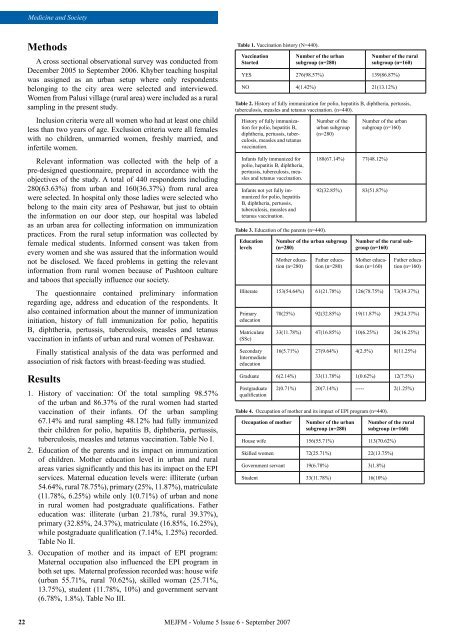Contents - Middle East Journal of Family Medicine
Contents - Middle East Journal of Family Medicine
Contents - Middle East Journal of Family Medicine
- No tags were found...
Create successful ePaper yourself
Turn your PDF publications into a flip-book with our unique Google optimized e-Paper software.
<strong>Medicine</strong> and Society<br />
Methods<br />
A cross sectional observational survey was conducted from<br />
December 2005 to September 2006. Khyber teaching hospital<br />
was assigned as an urban setup where only respondents<br />
belonging to the city area were selected and interviewed.<br />
Women from Palusi village (rural area) were included as a rural<br />
sampling in the present study.<br />
Inclusion criteria were all women who had at least one child<br />
less than two years <strong>of</strong> age. Exclusion criteria were all females<br />
with no children, unmarried women, freshly married, and<br />
infertile women.<br />
Relevant information was collected with the help <strong>of</strong> a<br />
pre-designed questionnaire, prepared in accordance with the<br />
objectives <strong>of</strong> the study. A total <strong>of</strong> 440 respondents including<br />
280(63.63%) from urban and 160(36.37%) from rural area<br />
were selected. In hospital only those ladies were selected who<br />
belong to the main city area <strong>of</strong> Peshawar, but just to obtain<br />
the information on our door step, our hospital was labeled<br />
as an urban area for collecting information on immunization<br />
practices. From the rural setup information was collected by<br />
female medical students. Informed consent was taken from<br />
every women and she was assured that the information would<br />
not be disclosed. We faced problems in getting the relevant<br />
information from rural women because <strong>of</strong> Pushtoon culture<br />
and taboos that specially influence our society.<br />
The questionnaire contained preliminary information<br />
regarding age, address and education <strong>of</strong> the respondents. It<br />
also contained information about the manner <strong>of</strong> immunization<br />
initiation, history <strong>of</strong> full immunization for polio, hepatitis<br />
B, diphtheria, pertussis, tuberculosis, measles and tetanus<br />
vaccination in infants <strong>of</strong> urban and rural women <strong>of</strong> Peshawar.<br />
Table 1. Vaccination history (N=440).<br />
Vaccination<br />
Started<br />
Number <strong>of</strong> the urban<br />
subgroup (n=280)<br />
Number <strong>of</strong> the rural<br />
subgroup (n=160)<br />
YES 276(98.57%) 139(86.87%)<br />
NO 4(1.42%) 21(13.12%)<br />
Table 2. History <strong>of</strong> fully immunization for polio, hepatitis B, diphtheria, pertussis,<br />
tuberculosis, measles and tetanus vaccination. (n=440).<br />
History <strong>of</strong> fully immunization<br />
for polio, hepatitis B,<br />
diphtheria, pertussis, tuberculosis,<br />
measles and tetanus<br />
vaccination.<br />
Infants fully immunized for<br />
polio, hepatitis B, diphtheria,<br />
pertussis, tuberculosis, measles<br />
and tetanus vaccination.<br />
Infants not yet fully immunized<br />
for polio, hepatitis<br />
B, diphtheria, pertussis,<br />
tuberculosis, measles and<br />
tetanus vaccination.<br />
Table 3. Education <strong>of</strong> the parents (n=440).<br />
Education<br />
levels<br />
Number <strong>of</strong> the<br />
urban subgroup<br />
(n=280)<br />
Number <strong>of</strong> the urban subgroup<br />
(n=280)<br />
Mother education<br />
(n=280)<br />
Number <strong>of</strong> the urban<br />
subgroup (n=160)<br />
188(67.14%) 77(48.12%)<br />
92(32.85%) 83(51.87%)<br />
Father education<br />
(n=280)<br />
Number <strong>of</strong> the rural subgroup<br />
(n=160)<br />
Mother education<br />
(n=160)<br />
Father education<br />
(n=160)<br />
Illiterate 153(54.64%) 61(21.78%) 126(78.75%) 73(39.37%)<br />
Primary<br />
education<br />
Matriculate<br />
(SSc)<br />
70(25%) 92(32.85%) 19(11.87%) 39(24.37%)<br />
33(11.78%) 47(16.85%) 10(6.25%) 26(16.25%)<br />
Finally statistical analysis <strong>of</strong> the data was performed and<br />
association <strong>of</strong> risk factors with breast-feeding was studied.<br />
Secondary<br />
Intermediate<br />
education<br />
16(5.71%) 27(9.64%) 4(2.5%) 8(11.25%)<br />
Results<br />
1. History <strong>of</strong> vaccination: Of the total sampling 98.57%<br />
<strong>of</strong> the urban and 86.37% <strong>of</strong> the rural women had started<br />
vaccination <strong>of</strong> their infants. Of the urban sampling<br />
67.14% and rural sampling 48.12% had fully immunized<br />
their children for polio, hepatitis B, diphtheria, pertussis,<br />
tuberculosis, measles and tetanus vaccination. Table No I.<br />
2. Education <strong>of</strong> the parents and its impact on immunization<br />
<strong>of</strong> children. Mother education level in urban and rural<br />
areas varies significantly and this has its impact on the EPI<br />
services. Maternal education levels were: illiterate (urban<br />
54.64%, rural 78.75%), primary (25%, 11.87%), matriculate<br />
(11.78%, 6.25%) while only 1(0.71%) <strong>of</strong> urban and none<br />
in rural women had postgraduate qualifications. Father<br />
education was: illiterate (urban 21.78%, rural 39.37%),<br />
primary (32.85%, 24.37%), matriculate (16.85%, 16.25%),<br />
while postgraduate qualification (7.14%, 1.25%) recorded.<br />
Table No II.<br />
3. Occupation <strong>of</strong> mother and its impact <strong>of</strong> EPI program:<br />
Maternal occupation also influenced the EPI program in<br />
both set ups. Maternal pr<strong>of</strong>ession recorded was: house wife<br />
(urban 55.71%, rural 70.62%), skilled woman (25.71%,<br />
13.75%), student (11.78%, 10%) and government servant<br />
(6.78%, 1.8%). Table No III.<br />
Graduate 6(2.14%) 33(11.78%) 1(0.62%) 12(7.5%)<br />
Postgraduate<br />
qualification<br />
2(0.71%) 20(7.14%) ----- 2(1.25%)<br />
Table 4. Occupation <strong>of</strong> mother and its impact <strong>of</strong> EPI program (n=440).<br />
Occupation <strong>of</strong> mother<br />
Number <strong>of</strong> the urban<br />
subgroup (n=280)<br />
Number <strong>of</strong> the rural<br />
subgroup (n=160)<br />
House wife 156(55.71%) 113(70.62%)<br />
Skilled women 72(25.71%) 22(13.75%)<br />
Government servant 19(6.78%) 3(1.8%)<br />
Student 33(11.78%) 16(10%)<br />
22<br />
MEJFM - Volume 5 Issue 6 - September 2007
















